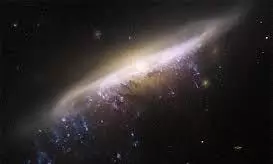
Hubble telescope photographs jellyfish-like galaxy 800 million LY away
text_fieldsWashington: NASA's Hubble Space Telescope has captured a galaxy that looks like a jellyfish. It is in the Pegasus constellation and over 800 million light years away.
The US space agency shared the image on Instagram and wrote: "A "jellyfish" galaxy, JW100, is seen in the lower right of this image from @NASAHubble. The streams of star-forming gas dripping from the disk of the galaxy resemble dangling tentacles, earning the galaxy its aquatic moniker."
It is the tentacles of light coming from the galaxy that makes it look like the marine animal. "One galaxy prominently resembles a jellyfish with its tentacles dangling in shades of yellow, blue, and green."
"The longer tentacles of this galaxy are caused by a process called ram pressure stripping; it occurs when galaxies collide with loose gases which are common in galaxy clusters. As a galaxy impacts these gases, they serve like a blast of wind, stripping gas and dust from the galaxy and creating the trail of debris that adorns JW100," explained the caption.
Ram pressure stripping happens when galaxies encounter the diffuse gas that pervades galaxy clusters. "As galaxies plough through this tenuous gas, it acts like a headwind, stripping gas and dust from the galaxy and creating the trailing streamers that prominently adorn JW100. The bright elliptical patches in the image are other galaxies in the cluster that hosts JW100," said a press note from the space agency.
"This observation took advantage of Hubble’s advanced capabilities. The data is part of a series of observations designed to explore star formation in the tentacles of jellyfish galaxies. These tentacles represent star formation under extreme conditions and could help astronomers better understand the process of star formation elsewhere in the universe," added NASA
"Toward the top of this image are two bright yellow blotches surrounded by a remarkably bright area of diffuse light. These galaxies likely grow by consuming smaller galaxies, so it’s not unusual for them to have multiple nuclei since it can take a long time for their cores to be absorbed. The bright points of light studding the galaxy’s outer fringes are a rich population of globular star clusters. The remainder of the image is sprinkled with stars and distant galaxies against the blackness of space," NASA wrote describing the image.
"This is the core of IC 5338, the brightest galaxy in the galaxy cluster. IC 5338 is an elliptical galaxy with an extended halo, a type of galaxy called a cD galaxy," NASA mentioned in the press note.























